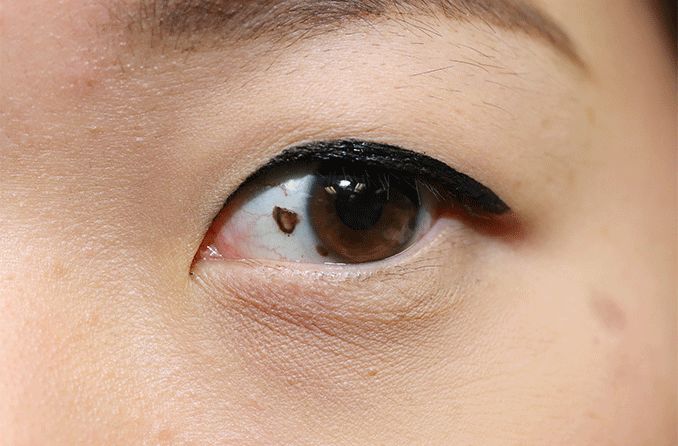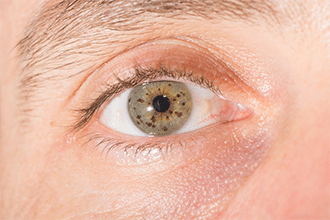What does an eye freckle mean?

Is it normal to see a freckle on my eye?
Seeing marks that resemble freckles in the colored (iris) or white (sclera) part of your eye is fairly common. This kind of spot is called a nevus (NEE-vus) and forms when melanin-producing cells clump together. They are comparable to the moles you see on your skin and are, in most cases, harmless.
What are the different types of eye freckles?
Like moles on your skin, eye freckles can be different colors and form in various regions of the eye, such as the iris, sclera or choroid. Some can be fairly noticeable, but others are much harder to see.
There are different names for the types of eye freckles a person can have:

Iris nevi are small, freckle-like spots that can develop within the pigmented cells of the iris.
A conjunctival nevus is a freckle that forms on the conjunctiva, which is the thin, clear tissue that covers the white of your eye (the sclera).
A choroidal nevus is a dark mark on the back of the eye (specifically, on the choroid) and can only be seen during an eye exam.
An iris nevus is a freckle in the colored portion of the eye (iris).
The placement of an eye freckle can often impact how visible it is. For example, a brown freckle against the white sclera is typically much more noticeable than a brown freckle on a colored iris.
What causes freckles to form on the eye?
Eye nevi — like freckles and moles — develop when melanin-producing cells cluster or clump together. These cells are called melanocytes, and they are responsible for the pigment that colors our skin, hair and eyes. There is a correlation between UV (ultraviolet) light exposure and the presence or formation of eye freckles (just like with regular freckles).
In many cases, people are born with eye freckles. These nevi do not usually present any health issues. Nevi can also form later on in life. These types of spots can be harmless as well, but they are more likely to develop into cancer.
SEE RELATED: Primary Acquired Melanosis (PAM)
How worried should I be about an eye freckle?
In general, eye freckles do not pose any health risks and can often go unnoticed. However, there are still a small number of cases in which an eye freckle can be a sign of a more serious condition, most notably ocular melanoma.
Ocular melanoma is a type of eye cancer that can develop in the cells that form a nevus. While it is the most common form of eye cancer, being diagnosed with ocular melanoma is still rare.
When it comes to figuring out if an eye freckle is a cause for concern, there are usually two questions you can ask yourself:
When did the freckle form?
Where is it in the eye?
Freckles that you’re born with are almost always benign. Nevi that form later in life run a higher risk of becoming ocular melanoma. Similarly, ocular melanoma is more common in choroidal nevi than it is in iris nevi or conjunctival nevi.
RELATED READING: Ocular melanoma
What are the signs that something could be wrong?
Unfortunately, ocular melanoma does not typically cause any early obvious symptoms. Some of the potential signs that a nevus may be cancerous include:
A visible freckle or mark increasing in size over a period of time.
Discomfort in the eyes or seeing “flashing lights.”
A choroidal nevus that measures more than two millimeters in thickness.
A choroidal nevus that is orange in color.
It can be hard to tell when a mole is abnormal, especially when the lesion is inside of your eye and already small and hard to see. This is why it’s important to stay up to date with your yearly eye health exams. You may not be able to recognize when an eye freckle is abnormal. An eye doctor can evaluate your eye freckle and assess whether it could be cancerous.
SEE RELATED: How often should you have an eye exam?
Can eye freckles affect my vision?
Eye freckles can form in different parts of the eye and are harmless in most cases. Even though the freckles are on the eye, they do not affect a person’s vision. A nevus is primarily a benign mark that forms when melanin-producing cells clump together.
However, if the nevus is cancerous, there is a higher chance that it could impact your vision as it grows in size. Some of the changes in vision that are associated with these tumors include blurry or distorted sight, a decrease in your visual field and seeing floaters.
A person will generally only receive treatment for an eye freckle if their doctor has reason to believe that it could be melanoma. To make sure this isn’t the case, it’s important to schedule an eye exam when you notice something irregular or different about your eyes. This is the best way to ensure that the health of your eyes is being managed and that any potential concerns are taken care of as early as possible.
READ MORE: Ocular Melanoma Awareness Month
Choroidal nevus. Wills Eye Hospital. Accessed November 2021.
Iris melanoma. Medscape. July 2021.
“Is a mole in the eye a medical condition?” American Academy of Ophthalmology. October 2012.
Nevus diagnosis and treatment. American Academy of Ophthalmology. October 2020.
Nevus (eye freckle). American Academy of Ophthalmology. October 2020.
Signs and symptoms of eye cancer. American Cancer Society. November 2018.
The sun, UV light and your eyes. American Academy of Ophthalmology. June 2020.
Understanding choroidal nevi. Ocular Melanoma Foundation. Accessed November 2021.
Nevus diagnosis and treatment. American Academy of Ophthalmology. October 2020.
What is ocular melanoma? American Academy of Ophthalmology. October 2020.
Page published on Thursday, November 18, 2021
Medically reviewed on Tuesday, November 16, 2021






